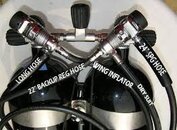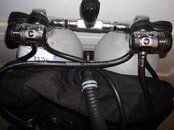In order for pressures to equalize the gasses in each cylinder must mix, the degree of mixing increasing as the total amount of gas diminishes through use, especially assuming that there is a greater draw from the regulator being used by the diver, and also assuming that the amount of gas needed to equalize is flowing from the tank under the unused first stage to the other tank. The more you breathe the more mixing taking place.
Wrong again. When you open the Iso valve gas will move from the tank at higher pressure *to* the tank at lower pressure, there will be *no* mixing in the tank that was at a higher pressure. If no new gas enters this tank *what* does it mix with?
When two tanks are freely connected it is not possible to draw from only one.
True, I've never said anything to the contrary, but you seem to think it happens with every breath.
If they are freely connected each cylinder will have the identical pressure.
True again, yet you contradict yourself by claiming that one is "drawing mostly from one tank" Can't keep your nonsense straight?
When breathing, you are either drawing mostly from one tank,
Complete and utter nonsense. By what mechanism does this magical gas flow "mostly from one tank"? It's
PRESSURIZED GAS. Physics demands the pressure to be equal *everywhere* inside both tanks and the manifold. The internal passage ways of the manifold are easily sufficient to maintain this equal pressure at any consumption rate a diver would impose. It would require a *tiny* restriction, like the hole drilled in the reg end of a HP hose to produce the phenomena you claim. This just isn't true. *Anybody* who has ever assembled a manifold knows this. You know, actually had their hands on one. Not quite the same as walking disinterestedly past a set of dubs at the LDS.
I've designed, built and operated fill stations, and I have designed and manufactured special purpose manifolds for rebreather. Manifolds based on the exact type we are now discussing. You are quite simply completely wrong. Both the designs I produced involved extending the length of the center section of the manifold, one using HP stainless tubing. I researched the cross sectional area need to avoid any measurable pressure differential across the manifold. I don't have my notes with me, but it's quite small, on the order of .035" IIRC. The internals of a typical manifold offer about 5 times that cross section.
What actually happens when a diver cracks a reg is gas is drawn from the manifold and the pressure in the manifold drops slightly. Both tanks, due to the drop in the manifold pressure supply gas to the manifold. Apparently you believe that when a diver cracks a reg gas flows "mostly" from one tank, and not from both due to to some as yet unspecified magical force, then it flows from the "other" tank, through the manifold, PAST the post orifice and into the first tank, mixes and then makes a U turn and flows back to the orifice. Remarkable, just remarkable. Magical thinking on display.
The mix taking place may be slight, at least initially, but it must take place. The laws of physics have not changed. When you remove more air from one of two openly connected paired tanks, you lower its pressure, causing gas from the other tank to effect equalization on however small a scale. If most of the mix takes place in the manifold the safety issue is, if anything, amplified.
More nonsense, you can't preferentially remove gas from one tank, the flow rates and internal cross section of the manifold won't allow it. Yet another illustration of your profound ignorance of the internals of a manifold.
There is nothing wrong with my ability to understand. It is churlish of you to make that kind of remark, especially when any calm consideration would compel you to admit that I am right.
I don't expect that to happen anytime soon.
Only a fool or a troll would repeatedly post on topics they know nothing about.
Tobin






